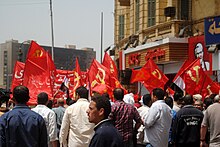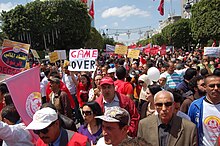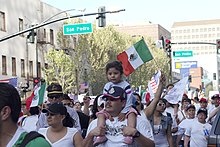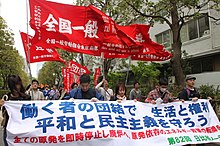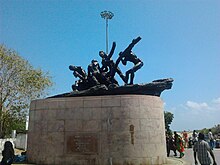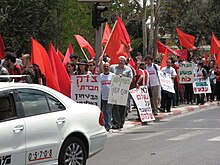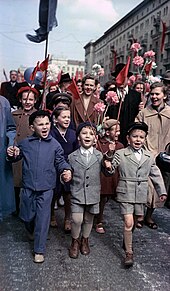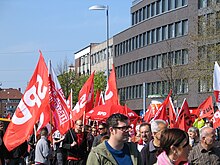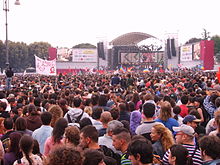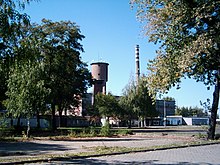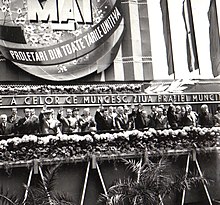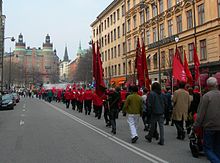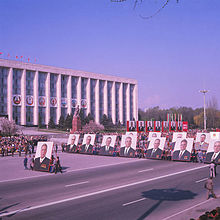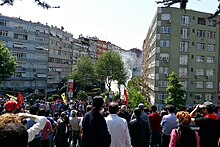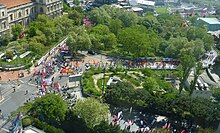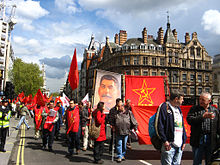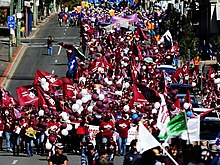Jump to navigation
Jump to search
International Workers' Day, also known as Workers' Day or Labour Day in some countries[1] and often referred to as May Day,[2][3] is a celebration of labourers and the working classes that is promoted by the international labour movement and occurs every year on May Day (1 May).[4][5]
While it may belong to a tradition of spring festivals, the date was chosen in 1889 for political reasons by the Marxist International Socialist Congress, which met in Paris and established the Second International as a successor to the earlier International Workingmen's Association. They adopted a resolution for a "great international demonstration" in support of working-class demands for the eight-hour day. The date had been chosen by the American Federation of Labor to continue an earlier campaign for the eight-hour day in the United States, which had culminated in the Haymarket affair, which occurred in Chicago on 4 May 1886. May Day subsequently became an annual event.[5] The 1904 Sixth Conference of the Second International, called on "all Social Democratic Party organisations and trade unions of all countries to demonstrate energetically on the First of May for the legal establishment of the eight-hour day, for the class demands of the proletariat, and for universal peace."[6]
The first of May is a national, public holiday in many countries across the world, in most cases as "Labour Day", "International Workers' Day" or a similar name. Some countries celebrate a Labour Day on other dates significant to them, such as the United States and Canada, which celebrate Labor Day on the first Monday of September.
Beginning in the late 19th century, as the trade union and labour movements
grew, a variety of days were chosen by trade unionists as a day to
celebrate labour. 1 May was chosen to be International Workers' Day to
commemorate the 1886 Haymarket affair in Chicago.[7] In that year beginning on 1 May, there was a general strike for the eight-hour workday.
On 4 May, the police acted to disperse a public assembly in support of
the strike when an unidentified person threw a bomb. The police
responded by firing on the workers. The event led to the deaths of seven
police officers and at least thirty-eight civilians; sixty police
officers were injured, as were one hundred and fifteen civilians.[8][9]
Hundreds of labour leaders and sympathizers were later rounded-up and
four were executed by hanging, after a trial that was seen as a
miscarriage of justice.[10][nb 1]
The following day on 5 May in Milwaukee Wisconsin, the state militia
fired on a crowd of strikers killing seven, including a schoolboy and a
man feeding chickens in his yard.[12]
| International Workers'Day | |
|---|---|

| |
| Official name | International Workers' Day |
| Also called | May Day |
| Celebrations | Various, depending on the country; mostly parades, marches, barbecues |
| Date | 1 May |
| Next time | 1 May 2021 |
| Frequency | Annual |
| Related to | |
While it may belong to a tradition of spring festivals, the date was chosen in 1889 for political reasons by the Marxist International Socialist Congress, which met in Paris and established the Second International as a successor to the earlier International Workingmen's Association. They adopted a resolution for a "great international demonstration" in support of working-class demands for the eight-hour day. The date had been chosen by the American Federation of Labor to continue an earlier campaign for the eight-hour day in the United States, which had culminated in the Haymarket affair, which occurred in Chicago on 4 May 1886. May Day subsequently became an annual event.[5] The 1904 Sixth Conference of the Second International, called on "all Social Democratic Party organisations and trade unions of all countries to demonstrate energetically on the First of May for the legal establishment of the eight-hour day, for the class demands of the proletariat, and for universal peace."[6]
The first of May is a national, public holiday in many countries across the world, in most cases as "Labour Day", "International Workers' Day" or a similar name. Some countries celebrate a Labour Day on other dates significant to them, such as the United States and Canada, which celebrate Labor Day on the first Monday of September.
Origin
In 1889, a meeting in Paris was held by the first congress of the Second International, following a proposal by Raymond Lavigne that called for international demonstrations on the 1890 anniversary of the Chicago protests.[5] May Day was formally recognized as an annual event at the International's second congress in 1891.[citation needed] Subsequently, the May Day riots of 1894 occurred. The International Socialist Congress, Amsterdam 1904 called on "all Social Democratic Party organisations and trade unions of all countries to demonstrate energetically on the First of May for the legal establishment of the 8-hour day, for the class demands of the proletariat, and for universal peace."[6] The congress made it "mandatory upon the proletarian organisations of all countries to stop work on 1 May, wherever it is possible without injury to the workers."[6]
In the United States and Canada, a September holiday, called Labor or Labour Day, was first proposed in the 1880s. In 1882, Matthew Maguire, a machinist, first proposed a Labor Day holiday on the first Monday of September[nb 2] while serving as secretary of the Central Labor Union (CLU) of New York.[13] Others argue that it was first proposed by Peter J. McGuire of the American Federation of Labor in May 1882,[14] after witnessing the annual labour festival held in Toronto, Canada.[15] In 1887, Oregon was the first state of the United States to make it an official public holiday. By the time it became an official federal holiday in 1894, thirty US states officially celebrated Labor Day.[14] Thus by 1887 in North America, Labour Day was an established, official holiday but in September,[16] not on 1 May.
A 1 May rally in Bucharest in 1967
In 1955, the Catholic Church dedicated 1 May to "Saint Joseph the Worker". Saint Joseph is the patron saint of workers and craftsmen, among others.[17]
During the Cold War, May Day became the occasion for large military parades in Red Square by the Soviet Union and attended by the top leaders of the Kremlin, especially the Politburo, atop Lenin's Mausoleum. It became an enduring symbol of that period.
Today, the majority of countries around the world celebrate a workers' day on 1 May.
By country
Africa
Algeria
In Algeria, 1 May is a public holiday celebrated as Labour Day.[18]Angola
1 May is recognized as public holiday in Angola and called Workers' Day.[19]Egypt
Egyptian Communist Party flags in Tahrir Square
1 May is known as Labour Day and is considered a paid holiday. The President of Egypt traditionally presides over the official May Day celebrations.[20]
Ethiopia
In Ethiopia, 1 May is a public holiday and celebrated as Worker's Day.[21]Ghana
1 May is a holiday in Ghana. It is a day to celebrate all workers across the country. It is celebrated with a parade by trade unions and labour associations.[22] The parades are normally addressed by the Secretary General of the trade union congress and by regional secretaries in the regions.[22] Workers from different workplaces through banners and T-shirts identify their companies.[22]Kenya
In Kenya, 1 May is a public holiday and celebrated as Labour Day. It is a big day addressed by the leaders of the workers' umbrella union body – the Central Organisation of Trade Unions (COTU). The Minister for Labour (and occasionally the President) address the workers. Each year, the government approves (and increases) the minimum wage on Labour Day.[23]Libya
International Workers' Day was declared a national public holiday by the National Transitional Council in 2012 the first year of the post-Qaddafi era.[24]On 1 May 1978, then Libyan leader Colonel Mu'ammar Al-Qaddafi addressed the nation in the capital city of Tripoli calling for administrative and also economic reforms across Libya.[25]
Morocco
It is recognized as a public holiday on 1 May.[26]Mozambique
Celebrates workers day on 1 May.[27]Namibia
1 May is recognized as public holiday in Namibia and celebrated as Workers' Day.[28]Nigeria
Since 1981, 1 May is a public holiday in Nigeria. On the day, people gather while, traditionally, the president of the Nigeria Labour Congress and other politicians address workers.[29]Somalia
In Somalia, 1 May is a public holiday and celebrated as the Labour Day.[30]South Africa
In South Africa, Workers' Day has been celebrated as a national public holiday on 1 May each year since 1995.[31] May Day started to get more attention by African workers in 1928, which saw thousands of workers in a mass march. In 1950, the South African Communist Party called for a strike on 1 May in response to the Suppression of Communism Act declaring it illegal. Police violence caused the death of 18 people across Soweto. It has its origins within the historical struggles of workers and their trade unions internationally for solidarity between working people in their struggles to win fair employment standards and more importantly, to establish a culture of human and worker rights and to ensure that these are enshrined in international law and the national law.[32]In 1986, the hundredth anniversary of the Haymarket affair, the Congress of South African Trade Unions (COSATU) called for the government to establish an official holiday on 1 May. It also called for workers to stay home from work that day.[33] COSATU was joined by a number of prominent anti-apartheid organizations, including the National Education Crisis Committee and the United Democratic Front (South Africa).[34] The call was also supported by a number of organizations regarded as conservative, such as the African Teachers Association, the National African Federated Chamber of Commerce, and the Steel and Engineering Industries Federation of South Africa, an organization that represented employers in the metal industries.[34] More than 1,500,000 workers observed the call and stayed home, as did thousands of students, taxi drivers, vendors, shopkeepers, domestic workers, and self-employed people.[34] In the following years, 1 May became a popular, if not official, holiday.[33] As a result of the killings on May Day 1950 and the success of COSATU's call in 1986, 1 May became associated with resistance to the apartheid government. After its first universal election in 1994, 1 May was adopted as a public holiday, celebrated for the first time in 1995.[33] On its website, the city of Durban states that the holiday "celebrate[s] the role played by trade unions and other labour movements in the fight against South Africa's apartheid regime".[35]
Tanzania
In Tanzania, it is a public holiday on 1 May and celebrated as the Worker's Day.[36]Tunisia
1 May is recognized as Labour Day within Tunisia.[37]Uganda
In Uganda, Labour Day is a public holiday on 1 May.[38]Zimbabwe
1 May is recognized as public holiday in Zimbabwe and called Workers' Day.[39]Americas
Argentina
In Argentina, Workers' Day is an official holiday on 1 May, and is frequently associated with labour unions. Celebrations related to labour are held including demonstrations in major cities.The first Workers' Day celebration was in 1890, when Argentinian unions organized several celebrations in Buenos Aires and other cities, at the same time that the international labour movement celebrated it for the first time.[40] In 1930, it was established as an official holiday by the Radical Civic Union president Hipólito Yrigoyen. The day became particularly significant during the worker-oriented government of Juan Domingo Perón (1946–55).[41] He permitted and endorsed national recognition of the holiday during his tenure in office.
Bolivia
1 May is known as Labour Day and is a holiday.[42]Brazil
In Brazil, Workers' Day is an official holiday that is celebrated on 1 May, and unions commemorate it with day-long public events. It is also when salaries for most professional categories and the minimum wage are traditionally readjusted.[citation needed]Canada
A notice about an anti-capitalist rally on Worker's Day in Montreal, 2011
May Day is however marked by unions and leftists. It is celebrated on 1 May. May Day is an important day of trade union and community group protest in the province of Quebec (though not a provincial state holiday). Celebration of the International Labour Day (or "International Workers' Day"; French: Journée internationale des travailleurs) in Montreal goes back to 1906, organized by the Mutual Aid circle. The tradition had a renaissance at the time of a mass strike in 1972. On the 1973 May Day, the first contemporary demonstration was organized by the major trade union confederations; over 30,000 trade unionists took part in this demonstration. Further, it is the customary date on which the minimum wage rises.[43]
Chile
President Carlos Ibáñez del Campo decreed 1 May a national holiday in 1931, in honour of the dignity of workers.[44] All stores and public services must close for the entire day, and the major trade unions of Chile, represented in the national organization Workers' United Center of Chile (Central Unitaria de Trabajadores), organize rallies during the morning hours, with festivities and cookouts in the later part of the day, in all the major cities of Chile. During these rallies, representatives of the major left-wing political parties speak to the assemblies on the issues of the day concerning workers' rights.Colombia
1 May has long been recognized as Labour Day and almost all workers respect it as a national holiday.[45] As in many other countries, it is common to see rallies by the trade unions in all over the main regional capitals of the country.[46]Costa Rica
First celebrated in 1913,[47] labor day is a public holiday, and at the same time an important day for government activities. On this day, the President of Costa Rica gives a speech to the citizens and the legislature of Costa Rica about the duties that were undertaken through the previous year. The president of the legislature is also chosen by its members.[48]Cuba
This day is known as Labour Day in Cuba. People march in the streets, showing their support to the Cuban Communist government and the Cuban Revolution during the whole morning.[49]Dominican Republic
1 May is a national holiday known as Labour Day and celebrated by workers' parades and demonstration.Ecuador
In Ecuador, 1 May is an official public holiday known as Labour Day. People do not go to work and spend time with their relatives or gather for demonstrations.[50]El Salvador
1 May is an official public holiday known as Labour Day.[51]Guatemala
1 May is an official public holiday known as Labour Day.[52]Haiti
1 May is an official public holiday known as Agriculture and Labour Day.[53]Honduras
1 May is an official holiday, known as "Labour Day" within Honduras.[54]Mexico
1 May is a federal holiday. It also commemorates the Cananea Strike of 1906 in the Mexican state of Sonora.Panama
1 May is an official public holiday, known as "Labour Day" within Panama.[55]Paraguay
1 May is an official public holiday, known as "Labour Day" within Paraguay.[56]Peru
1 May is an official public holiday, known as "Labour Day" within Peru.[57]United States
Socialists in Union Square, New York City, on 1 May 1912
Efforts to switch Labor Day from September to 1 May[citation needed] have not been successful.
In 1947, 1 May was established as Loyalty Day by the U.S. Veterans of Foreign Wars as a way to counter communist influence and recruitment at May Day rallies.[58] Loyalty Day was celebrated across the country with patriotic parades and ceremonies, however the growing conflict over U.S. involvement in Vietnam detracted from the popularity of these celebrations.[58] In 1958, the American Bar Association campaigned to have 1 May designated as Law Day, which was acknowledged in 1961 by a joint resolution of Congress.[59] Law Day exercises, such as mock trials and courthouse tours, are often sponsored by the American Bar Association.
Music, theatre and giant puppets mark the Milwaukee May Day commemoration.
San Jose, California, May Day March, 1 May 2006
On 1 May 2012, members of Occupy Wall Street and labor unions held protests together in a number of cities in the United States and Canada to commemorate May Day and to protest the state of the economy and economic inequality.[65][66]
On 1 May 2017, immigrants' rights advocates, labor unions and leftists held protests against the immigration and economic policies of President Donald Trump in cities throughout the US, Chicago and Los Angeles having some of the largest marches.[67][68]
On 1 May 2020, during the 2019–20 coronavirus pandemic, "workers from at Amazon, Whole Foods, Instacart, Walmart, FedEx, Target, and Shipt say they will walk off the job [...] to protest their employers’ failure to provide basic protections for frontline workers who are risking and losing their lives at work."[69] Additionally, on the same day, there will be a Rent strike, the largest in nearly a century.[70]
Uruguay
In Uruguay, 1 May – Workers' Day – is an official holiday. Even when it is associated with labour unions, almost all workers tend to respect it. Since the late 1990s, the main event takes place at the First of May Square in Montevideo.Venezuela
1 May is an official holiday in Venezuela. El Día del Trabajador is celebrated on 1 May in Venezuela since 1936, but from 1938 to 1945 it was held on 24 July, by an order of Eleazar López Contreras. However, Isaías Medina Angarita changed it back to 1 May in 1945.[71]Asia
East Asia
Mainland China
1 May is a statutory holiday in the People's Republic of China. Prior to 2008, it was a three-day holiday, but is now just the one day.[citation needed] However, it is usually supplemented by two other days to give the appearance of a three-day holiday, but not being statutory holidays the extra days have to be "made up" by working either the preceding or following weekend.[citation needed] For example, in 2013, 1 May fell on Wednesday. Most workplaces, including all government offices, took Monday 29 April, Tuesday 30 April, and Wednesday 1 May off. As the first two days were not statutory holidays they had to be "made up" by working the preceding weekend (27 and 28 April).Hong Kong
In Hong Kong, 1 May is known as Labour Day and has been considered a public holiday since 1999.Macau
In Macau, it is a public holiday and is officially known as Dia do Trabalhador (Portuguese for "Workers' Day").[citation needed]Taiwan
1 May is known as Labor Day in Taiwan, an official holiday, though not everybody gets a day off. Students and teachers do not have this day off.[72]Japan
2011 National Trade Union Council (Zenrokyo) May Day march, Tokyo
Some major labour unions organize rallies and demonstrations in Tokyo, Osaka, and Nagoya.[citation needed] Japan has a long history of labour activism and has had a communist and socialist party in the Diet since 1945. In 2008, the National Confederation of Trade Unions (Zenrōren) held a rally in Yoyogi Park attended by 44,000 participants, while the National Trade Unions Council (Zenrōkyō) held its May Day rally at Hibiya Park.[citation needed] Rengō, the largest Japanese trade union, held its May Day rally on the following Saturday (3 May), allegedly to distance itself from the more radical labour unions.[citation needed]
North Korea
In the Democratic People's Republic of Korea, 1 May is known as International Workers' Day, and is a public holiday. Celebrations, local meetings and rallies are held every year throughout the country to honor the holiday.[74] The Rungnado May Day Stadium in the capital of Pyongyang is named in honor of the holiday.South Korea
In the Republic of Korea, 1 May is known simply as "Workers' Day". It is not a public holiday, but a paid holiday for workers by the Designation of Workers' Day Act.[nb 3]South Asia
Bangladesh
In Bangladesh, 1 May Day is a public holiday and called May Day. A parade and other events are held on the day to commemorate the occasion.[76]India
Triumph of Labour at the Marina Beach in Chennai
The first May Day celebration in India was organized in Madras (now Chennai) by the Labour Kisan Party of Hindustan on 1 May 1923.[80] This was also the first time the red flag was used in India.[81] The party leader Singaravelu Chettiar made arrangements to celebrate May Day in two places in 1923. One meeting was held at the beach opposite to the Madras High Court; the other meeting was held at the Triplicane beach. The Hindu newspaper, published from Madras reported,
The Labour Kisan party has introduced May Day celebrations in Madras. Comrade Singaravelar presided over the meeting. A resolution was passed stating that the government should declare May Day as a holiday. The president of the party explained the non-violent principles of the party. There was a request for financial aid. It was emphasised that workers of the world must unite to achieve independence.[82]1 May is also celebrated as "Maharashtra Day"[83] and "Gujarat Day" to mark the date in 1960, when the two western states attained statehood after the erstwhile Bombay State was divided on linguistic lines. Maharashtra Day is held at Shivaji Park in central Mumbai. Schools and offices in Maharashtra remain closed on 1 May. A similar parade is held to celebrate Gujarat Day in Gandhinagar.
Vaiko (Vai Gopalsamy), General Secretary of Marumalarchi Dravida Munnetra Kazhagam, appealed to the then Prime Minister V. P. Singh to declare 1 May as a national holiday, to which the PM heeded and from then on it became a national holiday to celebrate International Labour Day.[84][non-primary source needed]
Maldives
Maldives first observed the holiday in 2011, after a declaration by President Mohamed Nasheed. He noted that this move highlighted the government's commitment as well as efforts of private parties to protect and promote workers' rights in the Maldives.[85]Nepal
1 May Day has been celebrated in Nepal since 1963.[86] The day became a public holiday in 2007.[87]Pakistan
International Labour Day is observed in Pakistan on 1 May to commemorate the social and economic achievements of workers. It is a public and national holiday. Many organized street demonstrations take place on Labor Day, where workers and labor unions protest against labor repression and demand for more rights, better wages and benefits.[88]Sri Lanka
In Sri Lanka, it is observed on 1 May and is a government and public holiday. The government has held official May Day celebrations in major towns and cities, with the largest being in the capital, Colombo. During celebrations, it is common to witness party leaders greeting the crowds. Workers frequently carry banners with political slogans and many parties decorate their vehicles.Southeast Asia
Cambodia
In Cambodia, it is known as International Labour Day and is a public holiday.[89] No marches for labour day were permitted in Cambodia for several years after the 2013 Cambodian general election and surrounding mass protetsts. A tightly controlled march on a limited scale was first permitted again in 2019.[90]Indonesia
Protest march in Jakarta, Indonesia, 1 May 2007
Malaysia
Malaysia began observing the holiday in 1972 following an announcement by the late Malaysian Deputy Prime Minister, Ismail Abdul Rahman.[92]Myanmar
In Myanmar, 1 May is known as Labour Day (Burmese: အလုပ်သမားနေ့) and is a public holiday.[93]Philippines
1 May is known as Labor Day (Filipino: Araw ng mga Manggaggawa) and is a public holiday in the Philippines. On this day, labour organizations and unions hold protests in major cities. On 1 May 1903, during the American colonial period the Unión Obrera Democrática Filipina (Filipino Democratic Labor Union) held a 100,000-person[94] rally in front of the Malacañang Palace demanding workers' economic rights and Philippine independence.[citation needed] Ten years later, the first official[by whom?] celebration was held on 1 May 1913 when 36 labour unions convened for a congress in Manila.[94] On 1 May 2001, a mass demonstration occurred near Malacañang Palace known as EDSA 3 or 1 May Riots.During the Presidency of Gloria Macapagal-Arroyo, a policy was adopted called holiday economics policy that moved holidays to either a Monday or a Friday to create a long weekend of three days. In 2002, Labor Day was moved to the Monday nearest to 1 May. Labour groups protested, as they accused the Arroyo administration of belittling the holiday.[95] By 2008, Labor Day was excluded in the holiday economics policy, returning the commemorations to 1 May, no matter what day of the week it falls on.[1]
Singapore
In Singapore, it is known as Labour Day and is a public holiday.[96]Thailand
In Thailand, the day is known in English as National Labour Day, and is one of 17 official public holidays in Thailand.[97]Vietnam
In Vietnam, it is known as International Labour Day (Vietnamese: Ngày Quốc tế Lao động) and is a public holiday. It was first celebrated in 1913.West Asia
Bahrain
In Bahrain, 1 May is known as Labour Day and is a public holiday.[98]Iran
In Iran, 1 May is known as the International Workers' Day. It is not a public holiday but according to article 63 of Iranian labour law on top of the official public holidays observed in the Islamic Republic of Iran, Labour Day shall be considered an official holiday for workers.[99]Iraq
In Iraq, it is known as the International Workers' Day and is a public holiday.[100]Israel
Israel, 1 May 2007
Jordan
1 May is known as Labour Day and is a public holiday.[102]Lebanon
1 May known as the Workers' Day and is a public holiday. Left-wing parties and workers' unions organize marches on 1 May.[103]Palestine
1 May is known as Labour Day and is a public holiday.[104][105][106]Syria
1 May is known as Labour Day and is a public holiday.[107]Europe
Eastern Bloc under communist governments
May Day rally in Moscow, 1 May 1960
Albania
Labour Day (Albanian: Dita e punëtorëve) is an official holiday celebrated on 1 May and thus schools and most businesses are closed.[109]Armenia
Labour Day (Armenian: Աշխատանքի օր, ashxatanki or) is an official holiday celebrated on 1 May.[110]Austria
Labour Day (Tag der Arbeit), officially called Staatsfeiertag (state's holiday), is a public holiday in Austria. Left parties, especially social democrats organize celebrations with marches and speeches in all major cities. In smaller towns and villages those marches are held the night before.Belgium
In Belgium, Labour Day (Dutch: Dag van de Arbeid, Feest van de Arbeid, French: Journée des travailleurs, Fête du travail), is observed on 1 May and is an official holiday since 1948.[111] Various socialist and communist organizations hold parades and other events in different cities.[112]Bosnia and Herzegovina
In Bosnia and Herzegovina, 1 and 2 May (Bosnian and Serbian: Prvi Maj / Први Mај, Croatian: Prvi Svibanj) are an official holiday and day-off for public bodies and schools at the national level. Most people celebrate this holiday by visiting natural parks and resorts. Additionally, in some places public events are organized. In its capital city, Sarajevo, 12 and 13 June are also celebrated as Labour day[citation needed] due to its many natural parks and springs.Bulgaria
Labour Day is one of the public holidays in Bulgaria, where it is known as Labour Day and International Workers' Solidarity Day (Bulgarian: Ден на труда и на международната работническа солидарност) and celebrated annually on 1 May.[113] The first attempt to celebrate it was in 1890 by the Bulgarian Typographical Association. In 1939, Labour Day was declared an official holiday. Since 1945 the communist authorities in the People's Republic of Bulgaria began to celebrate the holiday every year. After the end of socialism in Bulgaria in 1989 Labour Day continues to be an official and public holiday, but state authorities are not committed to the organization of mass events.[citation needed]Croatia
In Croatia, 1 May is a national holiday. Many public events are organized and held all over the country where bean soup is given out to all people as a symbol of a real workers' dish. Red carnations are also handed out to symbolise the origin of the day. In Zagreb, the capital, a major gathering is in Maksimir Park, which is located in the east part of Zagreb. In Split, the largest city on the coast, people go to Marjan, a park-forest at the western end of Split peninsula.[114] During World War II in Yugoslavia in the Independent State of Croatia under the Ustashe fascist regime it was marked in honor of labour, social justice and solidarity of workers.[115]Cyprus
In Cyprus, 1 May (Greek: Εργατική Πρωτομαγιά) is considered as an official Public Holiday (Labour Day). In general, all stores remain closed in public and private sector. The Labor Union and Syndicates celebrate with various festivals and events across the country.Czech Republic
In the Czech Republic, 1 May is an official and national holiday known as Labour Day (Czech: Svátek práce).[116]Denmark
In Denmark, 1 May is not an official holiday, but a variety of individuals, mostly in the public sector, construction industry, and production industry, get a half or a whole day off. It was first celebrated in Copenhagen in 1890. The location of the first celebration, the Fælledparken, still plays an important part today with speeches by politicians and trade unionists to mark the occasion. Many other events are also held around the country to commemorate the day.[117]Estonia
In Estonia, 1 May is a public holiday and celebrated as part of May Day (Kevadpüha). It also coincides with Walpurgis Day (volbripäev).Finland
A May Day rally in Helsinki, Finland
France
May Day demonstration in Lyon, France
Germany
In April 1933, the recently installed Nazi government declared 1 May the "Day of National Work", an official state holiday, and announced that all celebrations were to be organized by the government. Any separate celebrations by communists, social democrats or labour unions were banned.[citation needed] After World War II, 1 May remained a state holiday in both East and West Germany. In communist East Germany, workers were de facto required to participate in large state-organized parades on May Day.[citation needed] Today in Germany it is simply called "Labour Day" (Tag der Arbeit), and there are numerous demonstrations and celebrations by independent workers' organizations. Today, Berlin witnesses yearly demonstrations on May Day, the largest organised by labour unions, political parties, the far left and the leftist Autonomen.
May Day rally in Hanover, Germany, 1 May 2013
Annual street fairs have proven an effective way to prevent riots, and May Day in 2005 and 2006 have been among the most peaceful known to Berlin in nearly 25 years. In recent years, neo-Nazis and other groups on the far right, such as the National Democratic Party of Germany, have used the day to schedule public demonstrations, often leading to clashes with left-wing protesters, which turned especially violent in Leipzig in 1998 and 2005.[citation needed]
May Day violence flared up again in 2010. After an approved far-right demonstration was blocked by leftists, a parade by an estimated 10,000 leftists and anarchists turned violent and resulted in an active response by Berlin police.[121]
Greece
In Greece 1 May is an optional public holiday. The Ministry of Labour retains the right to classify it as an official public holiday on an annual basis, and it customarily does so.[122] The day is called Ergatikí Proto-magiá (Εργατική Πρωτομαγιά, lit. "Workers' 1 May") and celebrations are marked by demonstrations in which left-wing political parties, anti-authority groups, and workers' unions participate. On May Day in 2010, there were major protests all over Greece, most notably Athens and Thessaloniki, by many left, anarchist and communist supporters and some violent clashes with riot police who were sent out to contain the protesters. They opposed economic reforms, an end to job losses and wage cuts in the face of the government's proposals of massive public spending cuts. These reforms are to fall in line with the IMF-EU-ECB loan proposals, which demand that Greece liberalize its economy and cut its public spending and private sector wages, which many believe will decrease living standards.[123]Hungary
Hungary celebrates 1 May as a national holiday, with open-air festivities and fairs all over the country. Many towns raise May poles and festivals with various themes are organized around the holiday. Left-wing parties and trade unions hold public rallies commemorating Labour Day.[124]Iceland
In Iceland the Labour Day (Icelandic: Baráttudagur verkalýðsins) is a public holiday. The first demonstration for workers rights in Iceland occurred in 1923. A parade composed of trade unions and other groups marches through towns and cities across the country and speeches are delivered.[125] However, some private businesses are open, mainly in the capital.[126]Ireland
The Irish Congress of Trade Unions (ITUC) marks May Day with rallies take place in Belfast and Dublin and other events such as lectures, concerts and film screenings also take place around a wider May Day festival.[127][128] The first Monday in May has been a public holiday in the Republic of Ireland since 1994[129] and in Northern Ireland since 1978.[130] In the Republic the public holiday was demanded by the ITUC[131] and proposed by the Labour Party in negotiating its 1992–94 coalition government with Fianna Fáil, and marked the centenary of the ITUC's predecessor, the Irish Trades Union Congress.[132] The public holiday has no official designation, as "Workers' Day" or otherwise.[133] In 2005, Labour's Ruairi Quinn condemned, as a slight to workers, an alleged Fianna Fáil proposal to replace the May holiday with one on 24 April commemorating the 1916 Rising; in fact the proposal was for an extra holiday.[134]Italy
Traditional 1st May Concert in St. John Lateran square, Rome
Lithuania
First May Day is an official public holiday celebrated as International Work Day (Lithuanian: Tarptautinė darbo diena).[135] Celebrations for workers' day were mandatory during the Soviet occupation, and carry a negative connotation as a result today. As Lithuania declared its independence in 1990, Work Day lost its public holiday status, but regained it in 2001.[136][137]Latvia
First May Day is an official public holiday celebrated as Convocation of the Constituent Assembly of the Republic of Latvia, Labour Day.[138]Luxembourg
In Luxembourg, 1 May, called the Dag vun der Aarbecht ("Day of Labour"), is a legal holiday traditionally associated with large demonstrations by trade unions in Luxembourg City and other cities.[139]Malta
In Malta, 1 May is an official public holiday celebrated as "Workers' Day",[140] together with the religious feast of "Saint Joseph the Worker". (Saint Joseph's Day, 19 March, the saint's main feast, is also a public holiday in Malta.[140]) A free music event takes place on 1 May. The Maltese also celebrate Maltese accession to the European Union on 1 May 2004.Montenegro
1 May is an official public holiday and a day off work and a day out of school. It is the only official holiday from socialist times that is still officially celebrated.[141]Netherlands
In the Netherlands, 1 May or Labour Day (Dutch: Dag van de Arbeid) is not an official holiday.[142]North Macedonia
First May Day celebration of the Ottoman period in Skopje, 1909
Norway
Norway's former Prime Minister Jens Stoltenberg gives his 1 May speech in 2009 in Oslo, Norway.
Poland
1st May Coal Mine in Wodzisław Śląski, Poland
In Poland, May Day is closely followed by May 3rd Constitution Day. These two dates combined often result in a long weekend called Majówka, which may last for up to 9 days from 28 April to 6 May, at the cost of taking only 3 days off. People often travel, and Majówka is unofficially considered the start of barbecuing season in Poland.[citation needed]
Between these two, on 2 May, there is a patriotic holiday, the Day of the Polish Flag (Dzień Flagi Rzeczypospolitej Polskiej), introduced by a Parliamentary Act of 20 February 2004. The day, however, does not force paid time off.
In Soviet times, streets, places, squares, parks and also factories were frequently named in honor of International Workers' Day, such as 1 Maja Coal Mine in Wodzisław Śląski.
Portugal
In Portugal, the 1 May celebration (Portuguese: Primeiro de Maio) was suppressed during the dictatorship of António de Oliveira Salazar and Marcelo Caetanos Estado Novo regime. The first workers' day demonstration was held a week after the Carnation Revolution of 25 April 1974. It is still the largest demonstration in the history of Portugal. It is used as an opportunity for workers and workers' groups to voice their discontent over working conditions in demonstrations across Portugal, the largest being held in Lisbon. It is an official public holiday.[146]Romania
Delegates of the Romanian Communist Party on 1 May 1965
Russia
Russian Communist Workers' Party demonstration on 1 May 2008 in Izhevsk
Since 2014 a national civil parade is held on that day on Red Square with similar events held in major cities and regional capitals.
Serbia
In Serbia, 1 May (and also 2 May) is a day off work and a day out of school. It is one of the major popular holidays, and the only official holiday from socialist times that is still officially celebrated. People celebrate it all over the country. By tradition 1 May is celebrated by countryside picnics and outdoor barbecues. May is marked by warm weather in Serbia. In Belgrade, the capital, most people go to Avala or Košutnjak, which are parks located in Rakovica and Čukarica. People go around the country to enjoy nature. A major religious holiday of Djurdjevdan is on 6 May so quite often days off work are given to connect these two holidays and weekend, creating a small spring break. 1 May is celebrated by most of the population regardless of political views.Slovakia
In Slovakia, 1 May is an official holiday. Celebrations are held surrounding workers' day but are also connected with the commemoration of the entry of the Slovak Republic into the European Union (1 May 2004).[148]Slovenia
In Slovenia, 1 May and 2 May are public holidays. There are many official events all over the country to celebrate workers' day. In Ljubljana, the capital, the main celebration is held on Rožnik Hill in the city. On the night of 30 April, bonfires are traditionally burned.[149]Spain
May Day rally in Barcelona, Spain
Sweden
Swedish Social Democratic Party at May Day demonstration in Stockholm, Sweden in 2006. The party has dominated Swedish politics for nearly a century. The trade union palace in Stockholm is seen at the end of the picture.
Recognizing the central contributions of workers and international worker solidarity in Swedish social, economic, political and cultural development, May Day demonstrations are an important part of Swedish politics and culture for social democrats, left parties, and unions. In Stockholm the Social Democratic Party always marches towards Norra Bantorget, the historical, physical centre of the Swedish labour movement, where they hold speeches in front of the headquarters of the Swedish Trade Union Confederation, while the smaller Left Party marches in larger numbers[155] towards Kungsträdgården.
Since 1967, the Communist Party and its youth wing, Revolutionary Communist Youth, have held their own May Day march, known as Röd Front ('Red Front').[156] In 2016, Röd Front marches were held at 33 locations across the country.[157] The largest Röd Front marches are usually held in the industrial and financial port town of Gothenburg, Sweden's second-largest city and one of the party's strongholds.[158][159]
May Day in the Moldavian Soviet Socialist Republic in the 1970s
Switzerland
In Switzerland, the status of 1 May differs depending on the canton and sometimes on the municipality. Labour Day is known as Tag der Arbeit in German-speaking cantons, as Fête du travail in the French-speaking cantons, and as Festa del lavoro in the Italian-speaking canton of Ticino.- In the cantons of Basel-Landschaft, Basel-Stadt, Jura, Neuchâtel, and Zürich, Labour Day is an official public holiday equal to Sundays, based on federal law (Bundesgesetz über die Arbeit in Industrie, Gewerbe und Handel, article 20a).
- In the cantons of Schaffhausen, Thurgau, and Ticino, Labour Day is an official "day off" (Ruhetag). This is equal in practice to an official public holiday, but is not based on federal law and cantonal regulations may differ in details.
- In the canton of Solothurn it is an official half-day holiday (starting at 12 noon).
- In the canton of Fribourg, public servants get the afternoon off, many companies follow this practice.
- In the canton of Aargau it is not an official holiday, but most employees get the afternoon off.
- In the municipalities of Hildisrieden and Schüpfheim (both in the canton of Lucerne) as well as in Muotathal (canton of Schwyz), 1 May is an official public holiday, but as commemoration day of the local patron saint, not as Labour Day. In the other parts of the cantons of Lucerne and Schwyz, 1 May is a regular work day.
- In all other cantons, 1 May is a regular work day.[160]
Turkey
Istanbul May Day clashes in 2013
Workers marching to Taksim Square, 1 May 2012
Workers' Day was first celebrated in 1912 in İstanbul and in 1899 in İzmir. After the establishment of the Turkish Republic, it became an official holiday. In 1924, it was forbidden by a decree and in both 1924 and 1925, demonstrations were intervened by arm floats. In 1935, The National Assembly declared Workers' Day to be a holiday again.[162]
During the events leading to the 1980 Turkish coup d'etat, a massacre occurred on 1 May 1977 (Taksim Square massacre), in which unknown people (agents provocateurs) opened fire on the crowd. The crowd was the biggest in Turkish workers' history with the number of people approximating 500,000. In the next two years, provocations and confusion continued and peaked before the 1980 coup d'etat. The Workers' Day holiday was cancelled once again. Still, demonstrations continued with small crowds, and in 1996, three people were killed by police bullets, and a plain-clothes man who spied in the crowd was revealed and lynched by workers. On the same evening, a video broadcast on TV showed that two participants in the demonstration were lynched by far right-wing nationalist groups and this lynching occurred in front of police forces who were watching the scene with happy faces. Thus, 1 May 1996 has been remembered by workers' movements.[162]
In 2007, the 30th anniversary of the Taksim square massacre, leftist workers' unions wanted to commemorate the massacre in Taksim square. Since the government would not let them into the square, 580–700 people were stopped and 1 person died under police control. After these events, the government declared 1 May as "Work and Solidarity Day" but not as a holiday. In the next year, the day was declared as a holiday, but people were still not allowed to gather in Taksim Square.[163] The year 2008 was remembered with police violence in Istanbul. Police fired tear gas grenades among the crowds, and into hospitals and a primary school. Workers pushed forward so that in 2010, 140,000 people gathered in Taksim, and in 2011 there were more than half a million demonstrators.
After 3 years of peaceful meetings in 2013, meetings in Taksim Square were forbidden by the government. Clashes occurred between police and workers; water cannon and tear gas have been widely used.[164]
Ukraine
It is a public holiday in Ukraine, inherited from the Soviet era. Until 2018, 2 May was also a public holiday (as in the Soviet era), instead in 2017 Western Christianity's Christmas celebrated 25 December became a new Ukrainian public holiday.[165][166] The 1 May International Workers' Day remained a Ukrainian public holiday, although it was renamed (also in 2017) from "Day of International Solidarity of Workers" to "Labour Day".[166]In 2015, May Day rallies were banned in Kyiv and Kharkiv.[167]
Late May 2015 laws that ban communist symbols came into effect in Ukraine, thus banning communist symbols, singing the Soviet national hymn or the Internationale.[168]
According to Interior Minister Arsen Avakov during the 2016 May Day rallies in some major cities the number of police officers far outnumbered the number of rally participants.[169] With in Dnipro 193 policemen protecting 25 rally participants.[169]
United Kingdom
The Stalin banner belonging to the CPGB-ML, featured in every London International Workers' Day rally since 2008
There are many traditional May Day rites and celebrations, some of which have been held for hundreds of years. However, it was not until the late 20th century that May Day in Great Britain became linked to International Workers' Day, and the holiday is not officially a "Labour Day".
In recent years, the anti-capitalist movement has organized a number of large protests in London, Glasgow, Edinburgh, and Doncaster. In London, these have resulted in clashes with the police. In 2000, the clashes ended with a branch of McDonald's being smashed and a statue of Winston Churchill being given a grass Mohawk hairstyle. The Cenotaph was also defaced with graffiti.[171][172] In the last few years, demonstrations have been more peaceful, with marches and gatherings, particularly in central London.[173] The Conservative-led coalition government in March 2011 announced plans to move the May Day bank holiday to October to lengthen the tourist season,[174] although as of 2017 nothing had come of this. A London rally on May Day is organized by the London May Day Organising Committee.
Oceania
Australia
The Labour Day March in Brisbane, Queensland is the largest rally in Australia.
New Zealand
New Zealand workers were among the first in the world to claim the right for an eight-hour working day when, in 1840, the carpenter Samuel Parnell[176] won an eight-hour day in Wellington. Labour Day was first celebrated in New Zealand on 28 October 1890.[177] Labour day falls every year on the fourth Monday of October.See also
Notes
- 5월 1일을 근로자의 날로 하고 이 날을 "근로기준법"에 의한 유급휴일로 한다. ("The first day of May each year shall be designated as Workers' Day, which shall be a paid holiday under the 'Labor Standards Act'.)"[75]
References
- "Labour Day | NZHistory, New Zealand history online". nzhistory.govt.nz. Retrieved 30 August 2018.
Further reading
- Foner, Philip Sheldon (1986). May day: a short history of the international workers' holiday, 1886–1986. New York: International Publishers. ISBN 978-0-7178-0624-9.
External links
 Media related to International Workers' Day at Wikimedia Commons
Media related to International Workers' Day at Wikimedia Commons Media related to May Day at Wikimedia Commons
Media related to May Day at Wikimedia Commons- May Day Archive at the Marxists Internet Archive
- Photos of May Day in Red Square during the Soviet Union
Categories:
- May Day protests
- History of anarchism
- Labor history
- Labour movement
- May observances
- International observances
- Trade unions
- Protests
- Anti-capitalism
- Industrial Workers of the World
- Syndicalism
- Communism
- Socialism
- Public holidays in Russia
- Public holidays in the Soviet Union
- Public holidays in Sweden
- Public holidays in the United Kingdom
- Public holidays in Ukraine
- Public holidays in Vietnam
Languages
|title= (help)
|title= (help)
|url= value (help).
The Programme for a Partnership Government also committed the Government to appoint the first Monday in May to be a public holiday with effect from 1994, in recognition of the centenary of the foundation of the Irish Trades Union Congress. In deciding to introduce a new public holiday, the Government also took account of the fact ... that nine of our EC partners have a public holiday early in May.

